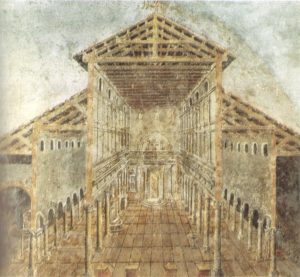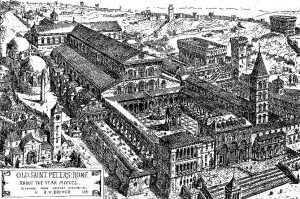The Old St. Peter’s Basilica was the building that stood, from the 4th to 16th centuries, on the spot where the new St. Peter’s Basilica stands today in Vatican City. Originally built in the 4th century, it was one of the most iconic structures in Christian history and has been a center of pilgrimage and worship for centuries. Nevertheless, the basilica still retains much of its original character and majesty. It is one of the Seven Pilgrim Churches of Rome and one of the four churches that hold the rank of major papal basilica.
History
Roman Emperor Constantine I (also known as Constantine the Great) ordered the construction of the original St. Peter’s Basilica to be erected over the site of St. Peter’s tomb, which was located just outside the walls of Rome at the time. This was around the early 4th century, and it took about 30 to 40 years to complete the building. It was a martyrium to commemorate St. Peter, one of Jesus Christ’s 12 disciples. St. Peter was considered the first bishop of Rome (first pope) and the first bishop of Antioch. The basilica held important religious events such as papal coronations, and over the next few centuries, it became one of the most prominent pilgrimage sites in Rome. Charlemagne (also known as Charles the Great) was crowned emperor of the Holy Roman Empire there by Pope Leo III on Christmas Day in 800.
Pilgrims weren’t the only ones attracted to Old St. Peter’s Basilica. Due to its popularity, raiders heard of the basilica’s extensive treasures. In 846, Saracens sacked the church. There were damages, with many of the basilica’s religious treasures and relics stolen, and St. Peter’s tomb destroyed. In response, Pope Leo IV had the Leonine Wall built and the destroyed parts of the basilica restored.
It wasn’t until the 1400s that significant changes were made to Old St. Peter’s Basilica. By this time, the church was falling into disrepair due to weather, age, and neglect. The pope at the time, Pope Nicholas V, commissioned Leon Battista Alberti and Bernardo Rossellino to begin planning for the construction of a new church. Alberti even commented that the church’s structure was unsafe and that because some walls already have holes, it wouldn’t take much for it to collapse eventually.
The exterior of the basilica was largely kept intact, with some minor changes and additions made. They renovated the atrium and the apse, but due to the pope’s death in 1455, the reconstruction of the basilica was never finished. Then in 1506, Pope Julius II commissioned the renowned architect Donato Bramante to begin construction on a new basilica that was meant to replace the old one. While Bramante was the primary designer, Michelangelo, Carlo Maderno, and Gian Lorenzo Bernini also had a hand in the planning and design of the new St. Peter’s Basilica. Construction started in April of 1506 and continued on for a hundred and 20 years until November of 1626.
Design and Architecture
The design of Old St. Peter’s Basilica was heavily influenced by Roman basilicas and audience halls, such as the Basilica Ulpia in Trajan’s Forum and Constantine’s own Aula Palatina at Trier. It was a typical basilica form with the plan and elevation resembling those of Roman buildings. It had a long nave that was approximately 250 feet. The nave was where the main body of the church was located and was usually the location of Holy Mass. During major events such as a papal coronation, the pope would sit in the apse and bless other bishops who were present at the event.
To each side are two smaller aisles that are divided by 21 marble columns that were taken from previously destroyed pagan buildings. In the 6th century, an atrium known as the “Garden of Paradise” was added. The atrium was a courtyard that’s located in front of the main entrance of the church. It has five doors that lead to the body of the basilica. The basilica was a large building that could accommodate up to 4,000 people. Old St. Peter’s Basilica was in the shape of a Latin cross with a gabled roof over 100 feet tall at the center. Saint Peter’s tomb was located below the high altar in the crypt.
The basilica contained important holy relics, such as the skull of Saint Andrew, the Holy Lance that pierced Jesus’ side, part of the Cross of Christ, and the Vernicle. These relics were housed in loggias built into the piers on which the dome rests. Each pilaster was decorated with Carrara marble to highlight the relic within and also featured two ancient columns adorned with vine leaves. You can also see intricate details such as mosaics, marble inlays, and frescoes on nearly every wall.
The art inside the basilica depicted scenes from both the Old and New Testament, as well as various other religious images. There was even a mosaic of Constantine and St. Peter located above the arch that led to the apse. One of the most famous mosaics in the basilica was called the Bark of St. Peter or Navicella (“little ship”), created by Giotto di Bondone. Located above the atrium, it showed Jesus Christ walking on water calling St. Peter to join him while the other disciples were in a boat behind them.
Old St. Peter’s Basilica has been renovated several times throughout the years, and the design and architecture of the church have changed with it. Despite this, it was an iconic building that stood as an important religious site for hundreds of years. Despite the numerous damages, it suffered over time; it remained a vital pilgrimage destination until it was replaced by the new St. Peter’s Basilica in the 17th century.

